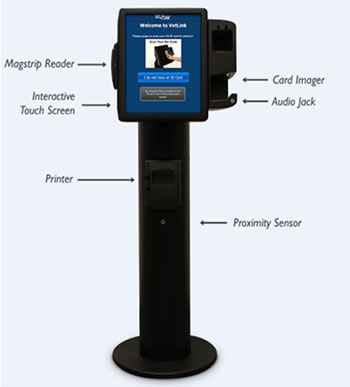From Frank Mayer blog Apr2020
As news reports detail the impact COVID-19 will have on our population and the healthcare system that serves it, many medical facilities have put systems in place to streamline services and keep frontline workers safe. Once the pandemic ends, these same procedures will remain, with clinics and hospitals looking to invest in strategies to maintain efficiency and facilitate patient and employee health.
Emergent technology like healthcare kiosks will be especially important to care providers moving forward, helping to restructure patient check-in, keep staff protected from communicable diseases, and offer easy telehealth options to less critical cases.
Healthcare kiosks streamline patient check-in
Simplifying processes continues to be an essential focus for the healthcare system, with facilities relying on websites to distribute information and nurse lines to vet cases that need to be seen immediately. These same types of efficiencies can be carried out in waiting rooms.
Offering patient check-in kiosks gives people control over their own registration process, ensuring less errors in recorded personal information and providing easy means to apply copays or pay bills at the kiosk. Streamlining these procedures frees front desk staff from data entry and allows them to focus on other tasks like scheduling or answering questions.
Delegating more control over the check-in process to the patient ensures hospital or clinic staff can concentrate on what’s most important – providing top medical care.
Minimize human-to-human contact with medical kiosks
The extensive spread of the novel coronavirus has spurred significant conversations about keeping public-facing employees safe in a variety of industries. This issue is especially vital in the healthcare industry where essential front desk staff are tasked with checking in potentially ill patients.
This greater awareness of human-to-human contact will live on with new measures to safeguard employees. Medical check-in kiosks can provide an important solution to the goal of maintaining proper social distance.
When patients can check in at a self-service kiosk, counter staff no longer risk being exposed to germs from sick individuals. Additionally, healthcare kiosks are easily disinfected. Staff can be tasked with cleaning the units, or kiosks can be outfitted with special attachments to hold sanitizing wipes or gel for patients.
Expect a solid future for telemedicine kiosks
As hospitals and clinics concentrate on keeping non-emergent illnesses out of facilities in order to make room for more critical cases, the use of telehealth options has increased.
With that, people are gaining a greater comfort level using alternative healthcare methods to communicate with a physician. In the future, telehealth kiosks placed in private areas of locations like pharmacies, schools, big box stores, and large businesses will not only provide access to medical care, but can be outfitted with special tools to help doctors retrieve necessary information like body temperature and blood pressure.
Telemedicine healthcare kiosks can also provide convenience to places with immune-compromised or elderly individuals like group homes and assisted living care facilities. These telehealth kiosks can provide on-site care easily and efficiently, reducing the need to risk exposure at a clinic or make travel arrangements for seniors to visit the doctor.
Conclusion
The pandemic has been a catalyst for innovative healthcare solutions to keep operations moving efficiently while ensuring safety is a top priority. When communities begin to emerge from the shadows again, expect beneficial technologies like patient check-in kiosks and telemedicine options to be a new expectation in the future of healthcare.
Contact Frank Mayer for more information
[contact-form to=”craig@catareno.com,info@frankmayer.com” subject=”Healthcare Kiosks FMA”][contact-field label=”Name” type=”name” required=”1″][contact-field label=”Email” type=”email” required=”1″][contact-field label=”Website” type=”url”][contact-field label=”Message” type=”textarea”][/contact-form]
More Links
https://patientkiosk.io/covid-19-delays-va-cerner-ehr-project/
https://patientkiosk.io/amazon-ehr-compatible-speech-to-text-translator/


